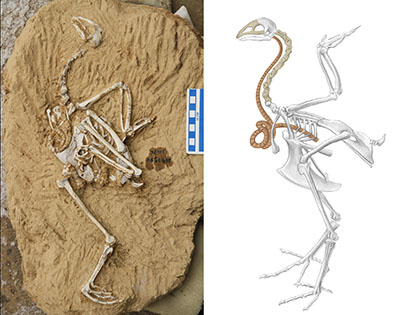On May 26, Zhou Zhonghe’s research team at the Institute of Vertebral Paleolithology reported in Scientific Reports a new pheasant fossil material with nearly complete skeleton preservation. The specimen was found in the Hezheng area of the Linxia Basin, an area adjacent to the Qinghai-Tibet Plateau. It dates back 7 to 11 million years. It preserves the earliest fossil of a bird's specialized curled and elongated trachea to date, and further contributes to the call (singing or singing). Tweets) the oldest evidence of change.
There are few fossils that directly indicate how extinct birds sang, but this new skeletal specimen provides us with new clues through the preservation of the shape of the tracheal cartilage. In the Linxia Basin of the late Miocene, widespread fine-grained clay coupled with rapid accumulation similar to debris flows, this rapid burial sedimentary environment and the accompanying protective effect of a large amount of clay surrounding rocks were very beneficial to the formation of fossils. This makes the area an important source of fossils of Cenozoic mammals and birds. The bird fossils and three-toed horse fauna here come from the Late Miocene Willow Formation.
The research team named this extinct bird Panraogallus hezhengensis based on its characteristic of surrounding the trachea. According to measurements, the length of the coiled pheasant's trachea is even greater than the body length of the bird, and the coiled part of the trachea is distributed in the subcutaneous tissue outside the chest cavity. Up to now, more than 60 kinds of modern birds with different types of elongated trachea have been documented. For example, in the extant galliformes, elongated tracheas appear in the Crested Pheasant in South America, the Guinea Fowl in Africa, and the Grouse family. of Thunderbirds. The newly discovered coiled pheasant is the earliest record of a pheasant fossil with this feature, and it is the first time it has been discovered among pheasant fossils.
It is estimated that the weight of the coiled pheasant is about 2.5 kilograms. The size of the body usually directly affects the size of the larynx of mammals, which in turn affects the frequency of sounds produced by mammals. The sounds of birds come from the syrinx (the part of the bronchi), and the trachea above the syrinx belongs to the vocal tract, so it evolved This super-elongated trachea is likely to produce a louder and richer sound, making it sound like a larger bird.
This "deceptive signal" is useful for intimidating predators and competitors and better attracting mates. It is similar to how many mammals have evolved longer tracheae. This "body exaggeration theory" has been further verified in new fossils and in comparative systematic analyses. Additional research has shown that in terrestrial mammal species where males are larger than females, males produce vocal signals that further exaggerate their size (e.g., by using the descent of the larynx to extend the length of the oropharyngeal cavity in order to reduce the frequency of the sound) .
Like living birds, this longer trachea is mostly found only in male birds. This specimen also preserves another obvious male individual characteristic, that is, the tarsometatarsus (lower leg bone) preserves a bulge similar to the spur of living male pheasants.
Currently, next to the mountain system created by the uplift of the Qinghai-Tibet Plateau, the Hezheng area has risen to more than 2,000 meters, but it was once a subtropical grassland where the coiled pheasant and many other birds and three-toed horses lived here. This study provides more evidence for understanding the ecological diversity of pheasants.
The area where the coiled pheasant lives once echoed with the rich calls of rhinos, horses, ostriches, kestrels and pheasants, but now they have disappeared from this land.
This research was funded by the Pilot Project of the Chinese Academy of Sciences and the General Project of the Natural Science Foundation, as well as the strong support of the Hezheng Paleontology and Fossil Museum.
Paper link:www.nature.com/articles/s41598-018-26178-x ?from=timeline&isappinstalled=0

Photos of the holotype specimen of the Coiled Pheasant (photo provided by Li Zhiheng) and scientific reconstruction of the skeleton (Guo Xiaocong)
animal tags: birds evolution fossil song extinction
We created this article in conjunction with AI technology, then made sure it was fact-checked and edited by a Animals Top editor.